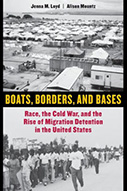Boats, Borders, And Bases: Race, The Cold War, And The Rise Of Migration Detention In The United States

Author: Jenna M. Lloyd and Alison Mountz
Publisher: University of California Press, 2019. 301p.
Reviewer: Kristina Shull | September 2019
Long-neglected by scholars of mass incarceration and migration alike, the U.S. immigration detention system is attracting increasing concern and media attention in the Trump era. Much of this coverage, however, lacks historical context. A majority of scholarship on migrant detention focuses on the explosive growth of the system since 9/11 and on the US-Mexico border as a primary enforcement site. Boats, Borders, and Bases contributes to an emerging body of scholarship that fills gaps in these narratives by illuminating the deeper and less visible Cold War and Caribbean roots of the contemporary detention system.
The book’s narrative spans the Carter to Clinton administrations, with a particular focus on the Reagan administration. Its central argument is that U.S. Cold War foreign and immigration policy responses to Cuban and Haitian migrations in the late 1970s and early 1980s established the legal and institutional basis for today’s migration-detention and border-deterrence regime. Racialized and recurring migration “crises” during these years cast the border as porous and out of control in both the public and policymakers’ eyes. The “spectacular dynamics” of these crises have drawn and distracted our attention to enforcement practices along the physical US-Mexico border, meanwhile justifying the establishment of a new geography of detention policies, practices, and facilities that extends both within and beyond our national boundaries. Loyd and Mountz argue that in the system’s build-up, emergency detention practices have come first — followed by legislation.
The authors, established scholars in critical geography and prison studies, make ground-breaking contributions in their archival approach and detailed tracing of detention policy decision-making. Drawing upon the presidential papers of Carter, Reagan, Bush, and Clinton, administrative files, and media sources, the authors reveal the centrality of race and Cold War politics in the contemporary system’s origins. The Caribbean holds key symbolic and strategic importance as new detention-as-deterrent practices were forged in response to increasing arrivals of Cuban and Haitian “boat people” in the late 1970s and early 1980s. This history is at once local and transnational, as politicians, administrators, and communities clashed over the Reagan administration’s plans to build new detention facilities. Loyd and Mountz remind readers of the ongoing resistance mounted against detention’s abuses led by those detained and their allies on the outside. Finally, they reveal the racism Afro-Caribbean migrants faced, and how anti-blackness drove immigration enforcement policymaking and the criminalization of migration since the 1980s — or “crimmigration” as scholars call this phenomenon. In all, Boats, Borders, and Bases rightly places immigration enforcement within the broader use of mass incarceration.
The book is organized into three parts, with Part One titled, “Race and the Cold War Geopolitics of Migration Control.” Chapter One introduces readers to “America’s Boat People,” referring to mass migrations of Indochinese, Haitian, and Cuban refugees arriving to the United States by sea in the mid to late 1970s. Due to foreign policy priorities, racial anxieties, and the U.S. public’s growing “compassion fatigue” amidst economic recession, Cuban and Haitian arrivals did not receive as warm a welcome as refugees of the Vietnam War, and prompted a more punitive response. The Mariel Cuban boatlift of 1980, during which 130,000 Cubans arrived in southern Florida over five months’ time, concurrent with the Carter-Reagan election, marked the height of a perceived immigration emergency. Carter and Reagan administrative responses to Mariel reveal, “how the recurrent invocation of crisis resulted in the development of an onshore deterrence infrastructure.” Once in office, the Reagan administration established new enforcement policies to deter future migrations from Latin America; namely, policies for the mandatory detention of asylum-seekers, the interdiction of Haitians on the high seas, and the development of long-term detention sites as “contingency planning.”
Chapter Two traces how this coordinated, on-shore, off-shore deterrence policy developed in response to the “Cuban-Haitian” crisis, was envisioned by the Reagan administration as necessary to prevent another mass migration like Mariel from occurring. Refugee management became increasingly punitive and militarized during this time, as military bases in the U.S. interior and in Puerto Rico served as contingency detention sites, and prompted the building of long-term detention facilities and shifted responsibility for detaining arriving asylum-seekers from FEMA to the INS and Bureau of Prisons. These new practices, however, met strong resistance. Migrants launched hunger strikes in detention, and civil and human rights groups protested and litigated against detention abuses. Meanwhile, KKK activity spiked in Arkansas where Cubans were detained, and elsewhere xenophobic communities launched “not in my backyard” campaigns against the building of new detention facilities. Loyd and Mountz also importantly document dissent from within the Reagan administration itself, as the Government Accountability Office challenged the need for and costs of detention.
Part Two, “Building the World’s Largest Detention System,” details the establishment of new physical and legal geographies of deterrence in Louisiana and Arizona respectively, in fulfillment of the Reagan administration’s 1982 “mass immigration emergency plan.” Chapter Three reveals the ad-hoc nature of the system’s expansion as local contesting of the building of proposed new detention centers resulted in the consolidation of a remote yet centralized infrastructure of detention and removal. The side-stepping of environmental laws to build a “mixed-use” Bureau of Prisons facility in Oakdale, Louisiana, complete with its own immigration court and airplane runway, exemplifies new trends as Oakdale citizens embraced the prison’s promise as an emerging post-industrial sunbelt economy.
Chapter Four turns to the state of Arizona, where prison overcrowding and building collided with immigration enforcement plans—resulting in new legal and administrative procedures to facilitate deportation and further enfold migrants into the criminal legal system. Arizona’s POW camps in Florence and Eloy post-WWII, created martial and carceral legacies that overlapped with security, labor, and criminal justice concerns to create new “landscapes of deterrence.” Most notable here for understanding the growth of migrant detention are: the enforcement enhancements of the 1986 Immigration Reform and Control Act (IRCA), the passage of legislation in 1988 requiring mandatory detention for “aggravated felonies,” and increasingly restrictive asylum adjudication processes—litigated against to some success. Subsequent administrations built upon these precursors to further expand the system.
Part Three, “Expanding the World’s Largest Detention System,” explores the continuation of these immigration and carceral crises to the present day. Chapter Five argues that new mass migrations from Cuba and Haiti in the early 1990s constituted a new era of “crisis” and prompted the Bush Sr. and Clinton administrations to build upon existing interdiction and off-shore detention practices. Through Operations “Safe Haven” and “Distant Shore,” the United States consolidated deterrence infrastructure in the Caribbean and formed agreements with third countries to provide temporary “safe haven” for migrants from Cuba and Haiti. In 1992, Haitian families and minors were detained at Guantánamo Bay, and migrants suspected of being HIV-positive were quarantined, sparking hunger strikes and civil rights litigation that successfully closed the camp.
Chapter Six returns to the “Onshore Expansion” of detention trends as Salvadoran and Guatemalan migrants fleeing civil wars created an asylum crisis in the 1980s. Loyd and Mountz also highlight the important role of subcontracting to local jails in incentivizing detention’s growth. In 1983-4, the INS contracted with the nation’s first private prison companies to build new, for-profit detention facilities, which was “but one element of the overriding issue of intergovernmental and subcontracting arrangements and their intense bureaucratization.” Ultimately, the detention system operates as an ad-hoc, flexible mix of local, federal, and private facilities connected by transport networks borne of military restructuring. Chapter Seven chronicles detention’s rapid growth after the Illegal Immigration Reform and Immigrant Responsibility Act (IIRIRA) of 1996 and the PATRIOT Act of 2001 expanded the nation’s detention mandate. Amidst spectacles of recurring immigration crises, Loyd and Mountz conclude, the United States casts itself as rescuer. Meanwhile, a less visible apparatus of boats, borders, and bases enforces what they call “global apartheid.”
What is the book’s key takeaway? The United States’ commitment to detaining migrants has always been tenuous and contestable. Today’s detention practices rely on a long-standing myth of perpetual migration crisis, manufactured during an era of heightened racial and Cold War anxieties. The real tragedy is that it did not and does not have to be this way.
My critiques of Boats, Borders, and Bases are minor; instead, I would point out areas left for further exploration. First, Central American migrants enter Loyd and Mountz’s narrative in the late 1980s, but there are important earlier connections between the incoming Reagan administration’s Cold War interventions in El Salvador and Guatemala’s civil wars and its imagining of impending migration crises. The detention of Salvadoran migrants in southern Texas and California, for example, and the highly visible resistance of the Sanctuary movement also played a key role in shaping detention policy, deterrent landscapes, and “crimmigration”—as exemplified in the retaliatory and surveillance operations of the INS and the FBI. Second, Loyd and Mountz are likely correct in concluding that prison privatization was not a prime driver boosting immigration detention numbers, at least not in the industry’s first decade; instead, laws that have criminalized migration have played this role. However, these factors have become intertwined, as increasingly laws criminalizing migration have been lobbied for and authored by private prison interests. Now, as over 70% of migrants in detention are held in for-profit facilities, we need to understand more of immigration’s role in Reagan’s broader privatization initiatives, the bipartisan public embrace of Reagan’s neoliberal turn that has normalized the commodification of bodies, and the devastating human cost.
Least visible here, and throughout scholarly and public discourse, are the voices and experiences of detained migrants themselves. In a recent review of Greg Grandin’s new book The End of the Myth: From the Frontier to the Border Wall in the American Mind (Metropolitan Books, 2019) in the New Yorker, novelist Francisco Cantú laments the lack of personal stories in most histories of immigration enforcement. He rightly claims this is due in large part to, “[t]he failure of the historical record to capture the voices, bodies, and places that have always had the least access to documentation.” It is our collective task, therefore, to continue to bring these histories to light.
Kristina Shull, Post-Doctoral Fellow in Global American Studies and Lecturer in Ethnicity, Migration, and Rights at Harvard University.


